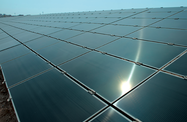Dubai is to change the way it powers itself, having announced a long-term plan to diversify the emirate’s energy sector away from dependence on imported gas and towards a broad-based mix of fuels for its power stations. However, that energy security could come at a cost.
On September 26, Saeed Al Tayer, the vice-chairman of Dubai’s Supreme Council of Energy, announced that a project to develop a large solar power plant would be launched soon as part of a wider programme to secure the emirate’s future energy needs. Within 20 years, Dubai intends to slash its dependence on imported natural gas, which currently meets 99% of the power sector’s fuel requirements, according to Al Tayer.
“In line with Dubai's energy strategy, the plan is to have 5% of renewables in the electricity supply mix. This is mainly going to be solar,” he told local media. “Soon we will have a very big project in Dubai. We are trying to find a date to announce it. We have identified the place.”
The solar power station is just part of a larger government scheme – the Integrated Energy Strategy 2030 – drafted to improve Dubai’s energy sector and safeguard supplies, Al Tayer said.
“12% of [Dubai’s] future energy could come from nuclear energy and another 12% will come from coal-fired power plants. 71% will come from gas and 5% from renewable energy,” said Al Tayer, who is also managing director and CEO of the Dubai Electricity and Water Authority (DEWA).
But diversifying power sources is not just about ensuring energy security. It is also about securing the environment. Dubai has developed a strategy to reduce carbon emissions by 30% by 2030, mainly by employing cleaner fuel stocks and using more efficient and environmentally friendly technology. Though it has a relatively small population, the UAE has some of the highest per capita emission rates of any country worldwide. Dubai’s proposed cut in carbon output will help improve air quality and lower pollution levels.
Not only will the use of renewable and cleaner fuel sources reduce Dubai’s carbon footprint, it will also cut the emirate’s import bill. Some estimates put the savings at around 30% of the total.
However, those future savings will not be made without significant outlays in the present, something acknowledged by Nejib Zaafrani, the secretary-general and CEO of the Supreme Council of Energy.
“The strategy of Dubai has looked at an array of alternatives, and we are talking about multi-billion dollars of investment until 2030,” he said in late September.
Two alternatives covered in the energy strategy, nuclear and coal-fired power stations, may seem to some to be at odds with the overall aim of safe and clean energy. However, officials say there are no plans to construct a nuclear power plant within the emirate. Dubai will receive part of the energy output from a station neighbouring emirate Abu Dhabi intends to build. As for coal being used as feedstock for power stations, the strategy has committed Dubai to clean technology, which should result in limited emissions.
One new development unlikely to have a major impact on domestic energy consumption but that will help fund the diversification of Dubai’s power production capacity will be the opening of a new oil field off the emirate’s coast. In early October, Sheikh Ahmad bin Saeed Al Maktoum, the chairman of the Supreme Council of Energy, announced that production at the new field would begin within a year.
While declining to give details on the anticipated volume of production or the field’s reserves, Sheikh Ahmad told reporters on October 3 it would make a notable increase to present output, which is estimated at around 100,000 barrels per day (bpd).
Though Samuel Ciszuk, a senior energy analyst with IHS Energy, said it was likely the new field was not particularly large and it would probably only slow falling production rates, any additional output remains welcome.
“All additions will make a difference to Dubai, given its small and declining overall output,” Ciszuk told Gulf News.
While welcome, the new field’s additional output will probably be drained off by the rising domestic market demand. Estimates put oil consumption in the UAE at just under 600,000 bpd by 2020, 27.5% up on present rates, according to details published by Arab Oil & Gas.
With the Supreme Council of Energy still reviewing progress on a coal-fired power station feasibility study, as well as further refining its energy strategy, it will be some time before the programme’s final details and estimated costs are released. All indications are the scheme’s budget will be massive. But, then, so should the benefits.

